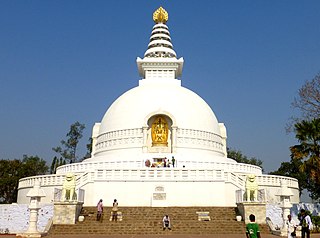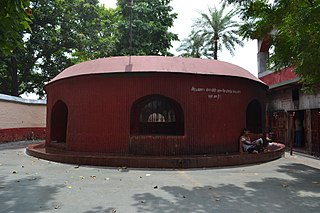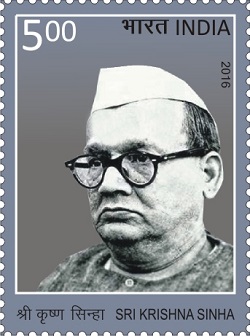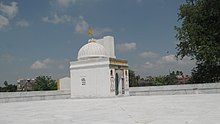
Bihar is a state in eastern India. It is the third largest state by population, the 12th largest by area, and the 14th largest by GDP in 2021. Bihar borders Uttar Pradesh to its west, Nepal to the north, the northern part of West Bengal to the east, and Jharkhand to the south. The Bihar plain is split by the river Ganges, which flows from west to east.

Rajgir, meaning "The City of Kings," is a historic town in the district of Nalanda in Bihar, India. As the ancient seat and capital of the Haryanka dynasty, the Pradyota dynasty, the Brihadratha dynasty and the Mauryan Empire, as well as the dwelling ground of such historical figures as The Buddha and The Mahavira, the city holds a place of prominence in Hindu, Buddhist and Jain scriptures. As of 2011, the population of the town was reported to be 41,000 while the population in the community development block was about 88,500.

Gaya is a city, municipal corporation and the administrative headquarters of Gaya district and Magadh division of the Indian state of Bihar. Gaya is 116 kilometres (72 mi) south of Patna and is the state's second-largest city, with a population of 470,839. The city is surrounded on three sides by small, rocky hills, with the Phalgu River on its eastern side.

Bihar Sharif is the headquarters of Nalanda district and the fifth-largest sub-metropolitan area in the eastern Indian state of Bihar. Its name is a combination of two words: Bihar, derived from vihara, also the name of the state; and Sharif. The city is a hub of education and trade in southern Bihar, and the economy centers around agriculture supplemented by tourism, the education sector and household manufacturing. The ruins of the ancient Nalanda Mahavihara, a UNESCO World Heritage Site, are located near the city.

Shikharji, also known as Sammed or Sammet Shikharji, is one of the Holiest pilgrimage sites for Jains, in Giridih district, Jharkhand. It is located on Parasnath hill, the highest mountain in the state of Jharkhand. It is the most important Jain Tirtha, for it is the place where twenty of the twenty-four Jain tirthankaras along with many other monks attained Moksha. It is one of the five principal pilgrimage destinations along with Girnar, Pawapuri, Champapuri, Dilwara, Palitana and Ashtapad Kailash.

Patna, the capital of Bihar state, India, is one of the oldest continuously inhabited places in the world and the history of Patna spans at least three millennia. Patna has the distinction of being associated with the two most ancient religions of the world, namely, Buddhism and Jainism. The ancient city of Pataliputra was the capital of the Mauryan, Shunga, and Gupta Empires.

Agam Kuan is an ancient well and archaeological site in Patna, India. It is said to date back to the period of Mauryan emperor, Ashoka. It is circular in shape, lined with brick in the upper 13 metres (43 ft) and wooden rings in the remaining 19 metres (62 ft).

The history of Bihar is one of the most varied in India. Bihar consists of three distinct regions, each has its own distinct history and culture. They are Magadha, Mithila and Bhojpur. Chirand, on the northern bank of the Ganga River, in Saran district, has an archaeological record dating from the Neolithic age. Regions of Bihar—such as Magadha, Mithila and Anga—are mentioned in religious texts and epics of ancient India. Mithila is believed to be the centre of Indian power in the Later Vedic period. Mithila first gained prominence after the establishment of the ancient Videha Kingdom. The kings of the Videha were called Janakas. A daughter of one of the Janaks of Mithila, Sita, is mentioned as consort of Lord Rama in the Hindu epic Ramayana. The kingdom later became incorporated into the Vajjika League which had its capital in the city of Vaishali, which is also in Mithila.
Aurangabad is a city in Aurangabad District, Bihar, India. It is the district's centre of governance and has a population of 102,244 as of 2011. The people of this region speak Magahi and Hindi.

Shri Krishna Singh (Sinha) (21 October 1887 – 31 January 1961), also known as Shri Babu, was the first chief minister of the Indian state of Bihar (1946–61). Except for the period of World War II, Sinha was the chief minister of Bihar from the time of the first Congress Ministry in 1937 until his death in 1961. Along with the Desh Ratna Rajendra Prasad and Bihar Vibhuti Anugrah Narayan Sinha (A.N. Sinha), Sinha is regarded among the 'Architects of Modern Bihar'. He also led the Dalit entry into the Baidyanath Dham temple (Vaidyanath Temple, Deoghar), which reflected his commitment towards the upliftment and social empowerment of the Dalits. He was the first chief minister in the country to abolish the zamindari system. He underwent different terms of imprisonment for a total of about eight years in British India. Sinha's mass meetings brought hordes of people to hear him. He was known as Bihar Kesari for his lionlike roars when he rose to address the masses. His close friend and eminent Gandhian Bihar Vibhuti A.N. Sinha in his essay Mere Shri Babu wrote that, "Since 1921, the History of Bihar has been the history of the life of Shri Babu".

Kirti Stambha is a 12th-century tower situated at Chittor Fort in Chittorgarh town of Rajasthan, India.

Vaishali, Vesali or Vaiśālī was a city in present-day Bihar, India, and is now an archaeological site. It is a part of the Tirhut Division.
Bhumihars, also locally called Bhuinhar and Babhan, are a Hindu caste mainly found in Bihar, the Purvanchal region of Uttar Pradesh, Jharkhand, the Bundelkhand region of Madhya Pradesh, and Nepal.

Bihar (Hindi: Bihar,, in eastern India is one of the oldest inhabited places in the world with a history going back 3000 years. The rich culture and heritage of Bihar is evident from the innumerable ancient monuments that are dotted all over the state. Bihar is home to many tourist attractions and is visited by large numbers of tourists from all over the world. Around total 6 million tourists visit Bihar every year.

Ranakpur Jain temple or Chaturmukha Dharana Vihara is a Śvētāmbara Jain temple at Ranakpur dedicated to Tirthankara Rishabhanatha. The temple is located in a village of Ranakpur near Sadri town in the Pali district of Rajasthan.

Kundalpur is a village in Nalanda district in the Indian state of Bihar. It is located about 2.5 kilometres from ancient Nalanda Mahavihara, 11 kilometres southwest of Bihar Sharif, and 80 kilometres southeast of Patna.

Jainism in Bihar trace a long history since the times of twenty-fourth Tirthankara Mahavira, who was born in Vaishali. The state of Bihar is considered to have played an important role in the development of Jainism.

Jain temple, Kundalpur is a complex of six Jain temples located in Kundalpur village near Nalanda, Bihar. Kundalpur is one of the most important Jain pilgrimages in Bihar.

Lachhuar Jain temple is a Jain temples located in Lachhuar village near Jamui, Bihar. Lachhuar is one of the most important Jain pilgrimages in Bihar.
















